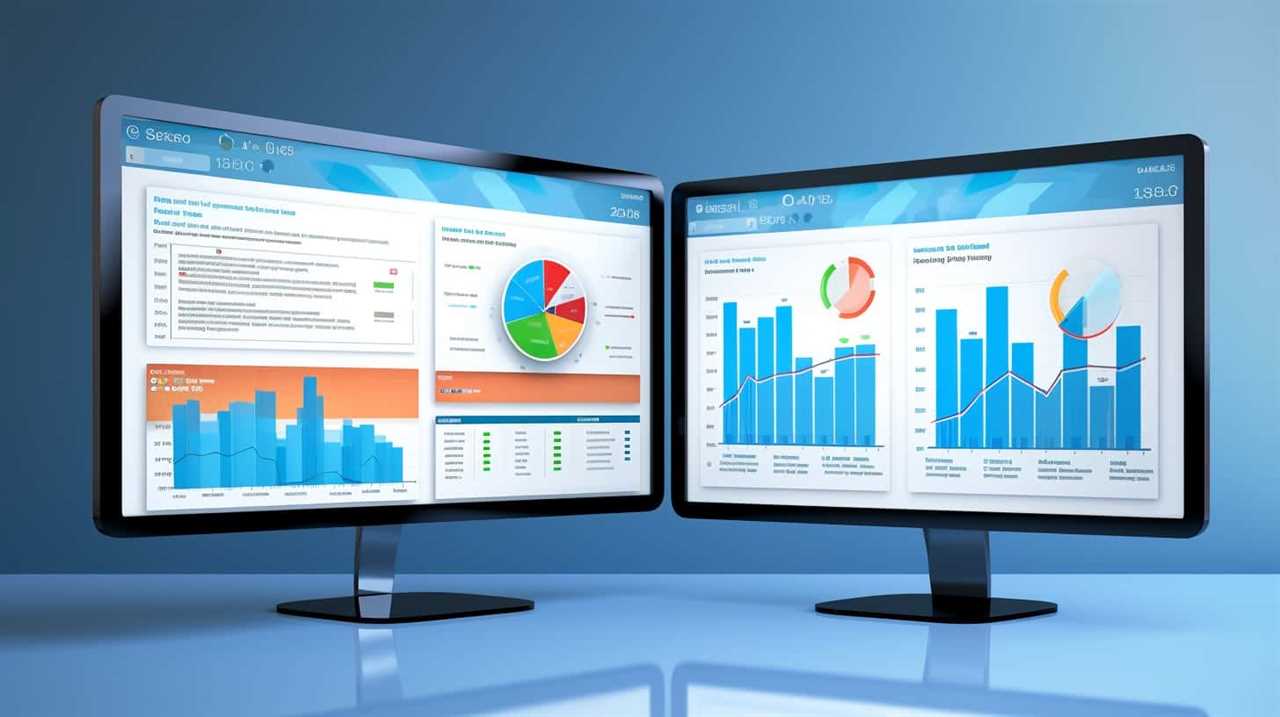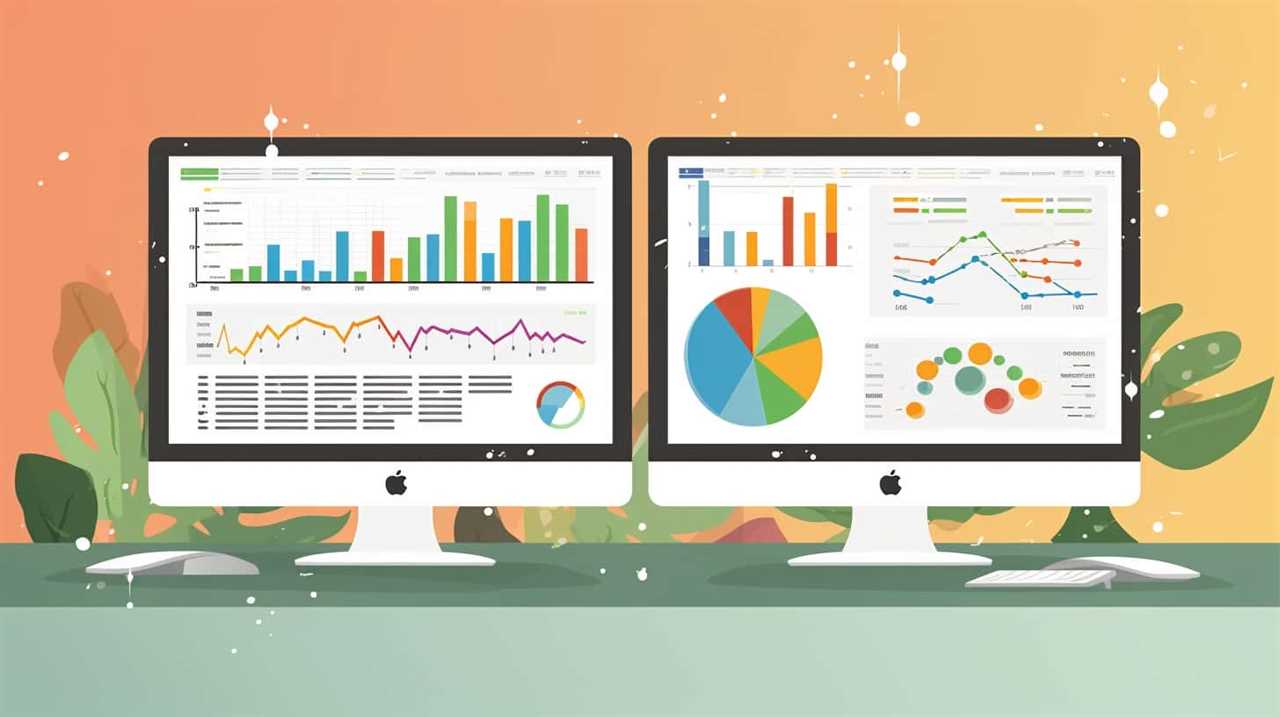Tired of always being eclipsed by your competitors? We’ve got the ideal solution to enhance your standings and dominate the local marketplace.
In this article, we’ll show you how to level up your SEO game as a local specialty grocer.
From understanding local SEO to optimizing your website and leveraging online reviews, we’ll guide you through the necessary steps to achieve search engine success.
Get ready to skyrocket your visibility and attract droves of hungry customers to your store.

Key Takeaways
- Local SEO optimization is crucial for specialty grocers to rank higher in local search results and attract local customers.
- Conducting thorough keyword research helps specialty grocers identify less competitive long tail keywords and create relevant content that aligns with user search intent.
- On-page SEO optimization, including mobile-friendliness, structured data implementation, and optimized meta tags and URLs, improves the visibility and user experience of specialty grocers’ websites.
- Creating high-quality and locally-focused content, engaging with the audience through blog posts, and encouraging user-generated content and reviews can greatly enhance the online presence and reputation of specialty grocers.
Understanding Local SEO
How can we effectively understand local SEO and use it to our advantage as local specialty grocers? As local specialty grocers, it’s crucial for us to have a strong online presence in order to attract and retain customers. Local SEO strategies for specialty grocers play a vital role in improving our online visibility and ensuring that our target audience can easily find us when searching for products in our area.
One of the key aspects of local SEO is optimizing our website for local searches. This involves including relevant keywords in our website content, meta tags, and URLs, as well as ensuring that our website is mobile-friendly and has a fast loading speed. Additionally, creating and optimizing our Google My Business profile is essential for local SEO success. This involves providing accurate and consistent information about our business, such as our address, phone number, and operating hours.
Another important aspect of local SEO is generating online reviews and managing our reputation. Positive reviews not only build trust and credibility with potential customers, but they also improve our search engine rankings. Encouraging satisfied customers to leave reviews and promptly addressing any negative feedback can greatly impact our online visibility.
Conducting Keyword Research
To effectively conduct keyword research for our local specialty grocer, we start by identifying the most relevant and commonly searched terms within our target market. This step is crucial for optimizing our website and content to appear higher in search engine results pages (SERPs). Here’s how we conduct our keyword research:

- Competitive analysis: We analyze our competitors’ websites and identify the keywords they’re ranking for. This helps us understand what keywords are driving traffic to their sites and gives us insights into potential keywords we can target as well.
- Long tail keywords: These are specific and highly targeted keywords that consist of three or more words. Long tail keywords have less competition and can help us attract more qualified traffic to our website. We use tools like Google Keyword Planner and SEMRush to find relevant long tail keywords for our specialty grocer.
- Search volume and trends: We analyze the search volume and trends of our chosen keywords to ensure they’re popular and align with our target market’s search behavior. This helps us prioritize our keyword targeting and focus on the terms that will drive the most traffic to our website.
- Keyword intent: Understanding the intent behind the keywords is essential. We consider whether the searcher is looking for information, wants to make a purchase, or is seeking a specific service. This helps us create content that meets the needs of our target audience and increases the chances of conversion.
Optimizing Your Website’s On-Page SEO
After conducting thorough keyword research, we can now move on to optimizing our website’s on-page SEO to further enhance our chances of outranking the competition in the local specialty grocery market. One crucial aspect of on-page SEO is mobile optimization techniques.
With the increasing use of smartphones and tablets, it’s essential to ensure that your website is mobile-friendly. This includes using responsive design, optimizing page load speed, and providing a seamless user experience across different devices.
Another effective strategy for on-page SEO is implementing structured data. Structured data helps search engines understand the content on your website better, which can lead to improved visibility in search results. By using schema markup, you can provide additional information about your products, such as their price, availability, and reviews. This can make your website more appealing to both search engines and users.
Furthermore, optimizing your website’s meta tags, headings, and URLs can also contribute to improved on-page SEO. By incorporating relevant keywords into these elements, you can increase the visibility of your website in search results. Additionally, optimizing your website’s images by using descriptive filenames and alt tags can enhance both user experience and search engine rankings.

Creating High-Quality Content
We can achieve better search engine rankings and outperform our competitors by creating high-quality content that engages and resonates with our target audience. When it comes to targeting a local audience, creating content that’s relevant and tailored to their needs is crucial.
Here are four key strategies to consider:
- Leverage the power of geotagging: Geotagging is the process of adding location data to your content, such as photos or blog posts. By geotagging your content, search engines can better understand the relevance of your content to a specific location. This helps improve your visibility to local users searching for products or services in your area.
- Focus on local keywords: Research and identify the keywords that are commonly used by your local audience when searching for specialty groceries. Incorporate these keywords strategically into your content, including in your headings, titles, and meta descriptions. This will help search engines understand the local relevance of your content and improve your chances of ranking higher in local search results.
- Create useful and informative content: Your content should aim to provide value to your target audience. This can be achieved by creating how-to guides, recipes, or blog posts that address common questions or concerns of your local customers. By offering informative and useful content, you establish yourself as an authority in your niche and build trust with your audience.
- Engage with your audience: Encourage your customers to leave reviews and comments on your website or social media platforms. Respond to their feedback promptly, and engage in conversations with them. This not only helps build a sense of community but also shows search engines that your business is active and responsive, further boosting your local search rankings.
Leveraging Online Reviews and Ratings
Our online reviews and ratings play a crucial role in establishing our reputation and attracting local customers to our specialty grocery store. Leveraging customer testimonials is an effective way to showcase the positive experiences of our customers and build trust with potential new customers.
When it comes to managing our online reputation, it’s important to actively monitor and respond to reviews and ratings.

Positive reviews can significantly impact our search engine optimization (SEO) efforts. Search engines like Google take into account the quantity and quality of online reviews when determining search rankings. By encouraging satisfied customers to leave reviews, we can improve our online visibility and outrank our competition.
Responding to reviews, whether positive or negative, is also essential. Engaging with our customers shows that we value their feedback and are committed to providing excellent service. It’s important to address negative reviews promptly and professionally, offering solutions or explanations to address any concerns.
In addition to leveraging customer testimonials, we can also use online ratings to our advantage. High ratings can be displayed prominently on our website and social media profiles, providing social proof and influencing potential customers’ purchasing decisions.
Building a Strong Backlink Profile
When it comes to building a strong backlink profile for your local specialty grocer, remember that quality is more important than quantity. Instead of focusing on getting as many backlinks as possible, prioritize acquiring high-quality links from reputable websites.

One effective way to do this is by submitting your business to local directories that are relevant to your industry and location. These directories can provide valuable backlinks that can help improve your website’s visibility and search engine rankings.
Quality Over Quantity
How can local specialty grocers build a strong backlink profile that emphasizes quality over quantity? Here are four key strategies to consider:
- Importance of customer reviews: Encourage satisfied customers to leave positive reviews on popular review platforms. These reviews not only help build trust and credibility but also serve as valuable backlinks to your website.
- The impact of local partnerships: Collaborate with other local businesses, such as farmers, artisanal producers, or restaurants, to create mutually beneficial partnerships. This can include guest blog posts, cross-promotions, or joint events. By linking to each other’s websites, you can increase your backlink profile with high-quality, relevant links.
- Focus on industry-specific directories: Submit your business to reputable directories that cater specifically to the food and grocery industry. These directories often have high domain authority and can provide valuable backlinks that boost your website’s visibility.
- Create shareable and valuable content: Produce informative and engaging content that resonates with your target audience. This could include blog posts, recipes, buying guides, or educational videos. When your content is valuable and shareable, it increases the likelihood of other websites linking back to it, improving your backlink profile.
Local Directory Submissions
To build a strong backlink profile that emphasizes quality over quantity, we can further enhance our SEO efforts through local directory submissions.
Local directory citations and local business listings play a crucial role in improving our online visibility and search engine rankings. These directories act as online directories where businesses can list their information, such as name, address, phone number, and website URL.

By submitting our information to these directories, we not only increase our chances of being found by local customers but also create valuable backlinks to our website. This helps search engines recognize our website as a reputable source and improves our organic search rankings.
In addition, local directory submissions can also boost our credibility and reputation in the local community.
Now, let’s explore how we can utilize social media for SEO and further strengthen our online presence.
Utilizing Social Media for SEO
By actively engaging on social media platforms, we can enhance our SEO efforts as local specialty grocers. Social media strategies and engagement tactics play a crucial role in improving our online visibility and driving organic traffic to our website.

Here are four ways we can utilize social media to boost our SEO:
- Regularly post high-quality content: Sharing informative and relevant content on social media not only engages our audience but also increases the chances of our content being shared and linked to by others. This can improve our website’s authority and boost our search engine rankings.
- Optimize social media profiles: Optimizing our social media profiles with relevant keywords, descriptions, and links can help search engines understand our business better and improve our chances of appearing in relevant search results.
- Encourage user-generated content: Encouraging our followers to create and share content related to our brand or products can generate valuable backlinks and social signals, both of which can positively impact our SEO efforts.
- Engage with our audience: Actively responding to comments, messages, and reviews on social media platforms not only improves our relationship with customers but also signals to search engines that we’re a reputable and trustworthy business.
Implementing Schema Markup
We implement Schema Markup to enhance our website’s visibility and improve our local specialty grocery store’s SEO performance. Schema Markup is a form of structured data that helps search engines understand the content on our website better. By implementing Schema Markup, we can provide search engines with additional information about our products, services, and business. This additional information helps search engines display rich snippets in search results, which can increase our click-through rates and improve our overall visibility.
One of the key benefits of Schema Markup is that it can help us stand out from our competition. By providing search engines with more detailed information about our business, such as our opening hours, customer reviews, and product information, we can increase our chances of appearing in relevant search results. This can help us attract more qualified traffic to our website and ultimately increase our sales.
When implementing Schema Markup, it’s important to follow some best practices. Firstly, we should choose the most appropriate Schema Markup types for our business. This could include types such as LocalBusiness, Product, and Review. Secondly, we should ensure that the Schema Markup is implemented correctly on our website, using the appropriate HTML tags and structured data formats. Finally, we should regularly test and validate our Schema Markup to ensure that it’s working correctly and providing search engines with the intended information.

Optimizing Your Google My Business Listing
Now let’s delve into optimizing our Google My Business listing to further enhance our local specialty grocery store’s SEO performance. Optimizing your Google My Business listing is crucial for improving your visibility in local search results.
Here are four essential steps to optimize your Google My Business listing:
- Claim and verify your listing: Start by claiming your business on Google My Business and verifying it. This will give you control over your listing and allow you to provide accurate information to potential customers.
- Optimize your business information: Make sure your business name, address, phone number, and website are accurate and consistent across all online platforms. This consistency helps search engines understand and trust your business information.
- Add relevant keywords: Incorporate relevant keywords in your business description, products/services, and posts. This will help your listing appear in search results when users search for those keywords.
- Encourage customer reviews: Positive customer reviews can significantly improve your local SEO. Encourage your customers to leave reviews on your Google My Business listing, and respond promptly to both positive and negative feedback.
Localizing Your Content Strategy
When it comes to localizing your content strategy for your specialty grocery store, there are a few key points to keep in mind.
First, targeting local keywords is crucial in order to attract customers in your area. By incorporating these keywords into your website content, you can increase your chances of appearing in local search results.

Additionally, geotagging your content with location-specific information helps search engines understand the relevance of your website to local users.
Lastly, building local backlinks from reputable sources can further boost your website’s visibility and credibility within your community.
Targeting Local Keywords
To effectively target local keywords and localize our content strategy, it’s essential to incorporate quantifier determiners to optimize our search engine rankings. Here are four key steps to help us achieve this:
- Conduct thorough local keyword research: By identifying the specific keywords that local customers are using to search for our products or services, we can tailor our content to meet their needs and improve our visibility in local search results.
- Optimize local landing pages: Creating dedicated landing pages for each location or area we serve allows us to target relevant local keywords and provide valuable information to potential customers. This helps search engines understand our business’s relevance to local searches.
- Include location-specific information: Incorporating city or neighborhood names, addresses, phone numbers, and other location-specific details in our website content and metadata helps search engines associate our business with specific geographical areas.
- Leverage online directories and review platforms: Listing our business on local directories and encouraging customers to leave reviews can boost our visibility in local search results and improve our online reputation.
Geotagging Your Content
We incorporate geotagging into our content strategy to localize our specialty grocery store’s online presence and enhance our SEO efforts.

Geotagging involves adding location-based metadata to our content, such as photos, blog posts, and social media updates. By doing so, we can target specific geographical areas and attract local customers who are searching for products and services in our vicinity.
Geotagging benefits us in several ways. Firstly, it helps search engines understand the relevance of our content to local searches, boosting our search rankings. Secondly, it allows us to create location-specific content that resonates with our target audience.
Building Local Backlinks
Continuing from our previous discussion, let’s dive into the importance of building local backlinks to further localize our content strategy. Local outreach and influencer partnerships are crucial for boosting our website’s visibility and credibility within the local community. Here’s why:
- Enhanced Local SEO: Local backlinks from reputable local websites signal to search engines that our business is relevant to the local area, improving our ranking in local search results.
- Increased Online Visibility: By securing backlinks from local websites, we increase our chances of appearing in front of our target audience, driving more organic traffic to our website.
- Established Authority: When local influencers or community leaders endorse our business through backlinks, it enhances our brand’s authority and reputation within the local market.
- Targeted Traffic: Local backlinks help us attract highly targeted traffic from users who are more likely to convert into customers, as they’re already interested in local businesses and products.
To effectively build local backlinks, we should engage in local outreach, reaching out to local websites, bloggers, and influencers to collaborate on content or feature our business. By fostering influencer partnerships, we can tap into their existing audience and gain valuable backlinks that drive local traffic to our website.

Monitoring and Analyzing Your SEO Performance
Monitoring and analyzing our SEO performance is crucial for local specialty grocers to stay ahead of the competition. By regularly assessing our website’s performance, we can identify areas for improvement, track keyword rankings, and stay on top of our competitors.
One effective way to monitor our SEO performance is by analyzing our competitors. By studying their strategies and tactics, we can gain insights into what is working in the industry and identify opportunities to differentiate ourselves. This could include analyzing their keyword usage, backlink profiles, and content strategies.
Tracking keyword rankings is another essential aspect of monitoring SEO performance. By keeping a close eye on how our target keywords are performing in search engine results, we can gauge our visibility and make necessary adjustments to our optimization efforts. This allows us to identify any keyword gaps or opportunities and optimize our content accordingly.
To better understand the importance of monitoring and analyzing SEO performance, here is a table summarizing the key benefits:

| Benefits of Monitoring and Analyzing SEO Performance |
|---|
| Identify areas for improvement |
| Track keyword rankings |
| Stay ahead of competitors |
Staying Up-To-Date With SEO Best Practices
To stay current with SEO best practices, it’s essential for local specialty grocers to regularly update their strategies and tactics. By staying up-to-date with the latest SEO trends for local specialty grocers, you can ensure that your website remains optimized and visible to potential customers.
Here are four effective strategies for local SEO optimization:
- Focus on local keywords: Incorporate relevant keywords that are specific to your specialty grocery store and its location. This will help you rank higher in local search results.
- Optimize your website for mobile: With the increasing use of smartphones, it’s crucial to have a mobile-friendly website. Ensure that your website is responsive and loads quickly on mobile devices.
- Claim your Google My Business listing: This is a vital step in local SEO optimization. Fill out your business information accurately, including your store’s name, address, phone number, and operating hours.
- Encourage online reviews: Positive reviews can boost your local SEO efforts. Encourage satisfied customers to leave reviews on platforms like Google, Yelp, or Facebook.
Conclusion
In this fast-paced digital landscape, local specialty grocers must embrace the power of SEO to outrank their competition. By understanding local SEO, conducting keyword research, and optimizing on-page SEO, grocers can improve their online visibility. Creating high-quality content and leveraging online reviews can further enhance their search engine rankings. Optimizing Google My Business listings and localizing content strategies can help grocers target their specific audience. Monitoring performance is essential to track the effectiveness of SEO efforts. It’s crucial to stay updated with SEO best practices to ensure maximum visibility and success in the ever-evolving online world. So, let’s dive in and start outranking the competition!










